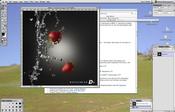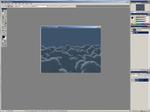| Sunday, February 24, 2002 |
12:27 - Phinally!
http://www.macworld.com/2002/04/features/photoshop/
|
(top)  |
At long last, we have a ship date for Photoshop 7.0 with its native Mac OS X support.
(Well, not so much a ship date as a ship quarter-- "Second quarter 2002"-- but it's something.)
Photoshop is for many people the last thing holding them back from upgrading to OS X, or if they already have, from ditching Classic. For me it's actually one of two things (I'm still waiting for a good Telnet/SSH program like NiftyTelnet), but now the floodgates can open for things like native scanner drivers, plug-ins (like AlienSkin), and all the other graphics tools that depend on Photoshop for their legitimacy.
I've always thought that Photoshop was one of the best reasons to use a Mac, because it takes advantage of two fundamental design features that make the Mac different from Windows: 1) The program takes up the entire screen area, and 2) no critical functions are handled by right-click/contextual menus.
It's been a longtime point of contention that Mac programs, when made active, take over the entire screen; click on any program, and its menus replace the menus at the top of the screen, rather than each individual program window having its own specific menus. There are arguments for and against both methods, and I'm not prepared to suggest that one is inherently better than the other. In many cases it's better to do it the Windows way-- to have menu controls be a part of the program window itself rather than up at the top of the screen, disconnected visually from the program you're working in. For "palette" style programs like ICQ and WinAmp, it makes more sense for all functionality to be encapsulated within the palette.

But programs like Photoshop showcase the very best reasons to have a program take over the entire desktop context. In Photoshop, you need all the space you can get; you have floating palettes docked all around the screen, and you need to see all your work images side by side, arranged so as to maximize space, with each picture taking up no more space in toolbars or title bars than you can possibly get away with. You need a global menu bar at the top, out of the way; hideable palettes that you can arrange around the edges of the screen, snapping them into position; and above all you need to be able to see behind the palettes to other programs you might be using.

A crucial part of Photoshop's workflow is the ability for images to float freely on the screen, so you can see them against the backdrop of a working desktop environment. You need to be able to see how the colors work together. You need to see how it a picture will look against a web page. But on Windows, this functionality is crippled by the MDI (Multiple Document Interface) scheme, which is quite possibly the ugliest interface metaphor ever dreamed up. A Windows program needs to maximize use of the desktop-- so it creates one gigantic, gray-background window with menu bars at the top, and all your palettes and windows float around inside the big gray box. It's opaque, drab, murky, and it prevents you from treating your images as objects on your desktop along with all your other objects, which is fundamental to how Photoshop needs to work.
The other thing about Photoshop is that it does not try to load functionality onto the right mouse button. Graphic art is a very complex set of tasks, and it's only going to confuse users if all the possible tasks are made into modal, contextual right-click options. Everything in Photoshop is accessed through the menus at the top, and right-clicking is reserved for quick shortcuts to tool-specific options (all of which can be accessed in the Tool palette). This is the philosophical extreme opposite from, say, the GIMP-- in which NO functionality is kept in menus, but EVERYTHING is accessed through modal, contextual right-click menus arranged in a deeply nested, impenetrable hierarchy. As I've said many times before, the GIMP's UI is a brilliant one-- as long as you're a robot. It's completely useless if you've ever used another piece of software in your life.
A single mouse button will allow a Photoshop user to accomplish every task possible, but will be a major liability in a program like GIMP. But in a more useful comparison, Photoshop could have succumbed to the Windows style of design and made itself a lot more like GIMP by loading functionality into the right mouse button-- but it hasn't. Why? Because graphic artists and designers are not geeks. They want a simple, concise, visually helpful layout for their tools, one that will guide them to the (often very complex) menu selections for what they want to do. They don't want to have to sit and wonder or experiment for hours to figure out whether the coffee-stain filter script is under a menu, or under a right-click option, or under a right-click-then-navigate-through-hierarchical-menus layout, or in a palette, or what. Using Photoshop is eminently possible with only one mouse button-- I've done it for years without ever right-clicking. And like the good student of design knows, if you want to know where to put the paths through your grounds, don't put in any paths-- just let the people walk where they want to walk, and next spring, pave the paths that they have worn in the grass. Likewise in software design: Observe that people want their functionality to be visible and accessible through the obvious means they have to hand (clicking on explicit menus), and design the functionality accordingly. Adobe has done this. And the result is a program that basks in the directness of the Mac OS user interface, rather than feeling as though it's crippled through a lack of right-click options (as many other programs do).
Photoshop 7.0 will be a $150 upgrade for registered users, so I'll be setting that aside for April. Now to hope that it's all Microtek is hoping for before they release a native OS X scanner driver. Pleasepleaseplease...
UPDATE: Matt Robinson says I'm right, and that I'm full of crap too. Read! Read it I say! And whatever you do, don't read it!
|
|



